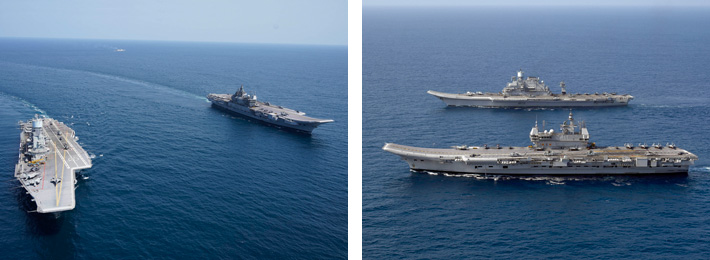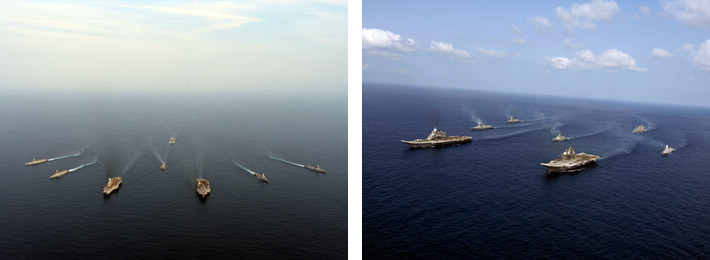INDIAN ARMED FORCES CHIEFS ON OUR RELENTLESS AND FOCUSED PUBLISHING EFFORTS

The insightful articles, inspiring narrations and analytical perspectives presented by the Editorial Team, establish an alluring connect with the reader. My compliments and best wishes to SP Guide Publications.

"Over the past 60 years, the growth of SP Guide Publications has mirrored the rising stature of Indian Navy. Its well-researched and informative magazines on Defence and Aerospace sector have served to shape an educated opinion of our military personnel, policy makers and the public alike. I wish SP's Publication team continued success, fair winds and following seas in all future endeavour!"

Since, its inception in 1964, SP Guide Publications has consistently demonstrated commitment to high-quality journalism in the aerospace and defence sectors, earning a well-deserved reputation as Asia's largest media house in this domain. I wish SP Guide Publications continued success in its pursuit of excellence.
Double Carrier Exercise
India's Two-Carrier exercise showcases Maritime power in the Indian Ocean, strengthening India's Naval Dominance and addressing Security Challenges in the Indian Ocean Region (IOR)
 |
The Author is Former Director General of Information Systems and A Special Forces Veteran, Indian Army |


India’s recent exercise of synergised operations of two aircraft carriers accompanied by several warships, submarines and over 35 aircraft in the Indian Ocean Region (IOR) created quite a sensation and was taken note of globally. The two carrier battle groups (CBGs) led by the Russian-origin INS ‘Vikramaditya’ and new indigenous INS ‘Vikrant’, each around 44,000-tonne cruising on the high seas unfettered by land boundaries, came together for the first time for the mega exercise in the Arabian Sea in an impressive demonstration. India’s primary area of strategic interest stretches from the Malacca Strait to the Persian Gulf. Capable of moving 400 to 500 nautical miles a day, a CBG is a floating air base with fighter jets and helicopters that can sanitise over 200 nautical miles around it.
Indian Navy spokesperson Commander Vivek Madhwal said, “This demonstration of naval prowess underscores India's commitment to safeguarding its national interests, maintaining regional stability, and fostering cooperative partnerships in the maritime domain,” It also marks “a significant milestone” in the Navy's pursuit of enhancing maritime security and power-projection in the IOR and beyond, he added. Madhwal further said that the successful demonstration of two-CBG operations serves as “a powerful testament” to the pivotal role of sea-based air power in maintaining maritime superiority. “In addition, they provide our friends with an assurance that the Indian Navy is capable and ready to support our 'collective' security needs in the IOR.”
India's INS 'Vikramaditya' and INS 'Vikrant' led two carrier battle groups in a joint exercise, highlighting India's commitment to maritime security and cooperative partnerships in the Indian Ocean Region (IOR).
As of now, India enjoys an advantage in the IOR due to the logistical issues faced by China, and can successfully exploit its “Malacca Dilemma” if the push comes to a shove. Two CBGs can effectively seal any choke points from both ends. INS Vikrant and INS Vikramaditya are mobile air bases that can be positioned anywhere, allowing for increased mission flexibility, timely response to emerging threats and sustained air operations to safeguard our national interests across the globe although INS ‘Vikrant’, the largest-ever warship to be built in India for about 20,000 crore, will only become fully combat-ready after the MiG-29K fighters complete their ongoing trials from her flight deck by early-2024.
The combat maneuvers with the “seamless integration” of the two CBGs, coupled with the recent long-range strike missions practiced by the IAF’s Rafale and Sukhoi-30 MKI fighter jets on the western and eastern seaboards, are being talked about as an unmistakable strategic signal to China about its vulnerabilities in the IOR. But among all the exuberance we must remember that China already has the world’s largest navy with 355 warships and submarines, already deploys seven to eight vessels and spy ships in the IOR at any given time, is helping Pakistan build a strong maritime force to challenge India in the Arabian Sea, and would also begin to deploy CBGs in the IOR in the near future.
The exercise showcased India's capability to project power and maintain maritime superiority with mobile air bases capable of rapid deployment and mission flexibility.
China presently has two aircraft carriers, ‘Liaoning’ and ‘Shandong’, and is fast completing the third, the over 80,000-tonne Fujian China’s eventual aim is to possess as many as 10 CBGs. Compare this to the Indian Navy, not even getting the preliminary nod for a third aircraft carrier, which will take over a decade to build. The Indian Navy is apparently finalising the initial case for a “repeat order” of INS Vikrant, instead of a more potent 65,000-tonne aircraft carrier due to budgetary constraints. India certainly needs three aircraft carriers, with one each for the eastern and western seaboards, while the third undergoes the periodic refit and maintenance cycle.
While we may exult in demonstrating the two CBGs exercise, China is well aware of our poor undersea capabilities. In comparison to China already operating 65 submarines, the Indian Navy’s fleet of attack submarines (all diesel-powered) has come down from 21 in the 1980s to just 16 at present. Only eight are battle-ready at any given time, as half of the fleet undergoes mid-life upgrades and is 30 years old. It has also been mentioned in these columns elsewhere that as and when India signs the deal for six stealth submarines with foreign collaboration (be it Germany, South Korea or Spain) it could take anything up to 10 years for the first of these submarines to become operational with the Indian Navy. Also, China is expected to deliver first of the eight submarines to the Pakistan Navy by end-2023 and all eight in the next decade.
The seamless integration of the two carrier battle groups, combined with recent long-range strike missions, sends a clear message to China about its vulnerabilities in the IOR.
Finally, we need to take a cue from China’s counter intervention strategy which includes the use of proxies, paralysing enemy C4ISR and ASAT capability, target airbases and ports, and kill aircraft carriers groups and submarines. Chinese researchers claimed in May 2023 that the country’s hypersonic missiles could destroy a US CBG with certainty leaving the US with limited options for assisting Taiwan in the event China invades. According to a report in The Washington Post of April 13, 2023, the US knew about this Chinese capability, which was among the top-secret Pentagon documents leaked recently. This implies that while exercising two-CBGs together was good, the Indian Navy needs to speedily develop comprehensive offensive defence capabilities.





